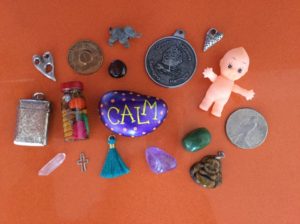Transitional Objects

Whether referred to as transitional objects, comfort objects, or “security blankets”, we tend to think of these as childhood occurrences. But many adults use transitional objects as tools to self-soothe and emotionally regulate; this holds particularly true for individuals who experienced developmental disruptions in early life. Adults may refer to such items as talisman, amulets, “lucky” items or protective charms. Transitional objects have the power of acting as emotional cues of comfort that can ground an individual in times of distress. The concept of transitional objects was first introduced by British psychoanalyst Donald W. Winnicott who posited that when all aspects of a child are not acknowledged and accepted by their primary caregiver (one’s “true Self”), a transitional object can create feelings of emotional safety that fosters independence. While too much dependence on a transitional object can be problematic, for many adults (myself included), they can act as small tools that comfort and ground a person. Transitional objects are not a sign of weakness, immaturity, or insecurity. Transitional objects are ritualistic in nature, a feature found and valued in all known human societies for the comfort and security they can offer.

My transitional object, “Jasper” (a small rubber elephant) and me chilling on the Red Sea, Egypt. To me, Jasper reminds me to not “sweat the small stuff”, to practice self-compassion, and to feel connected to Self wherever I am.
Anyone willing to share if they find comfort in a transitional object?
